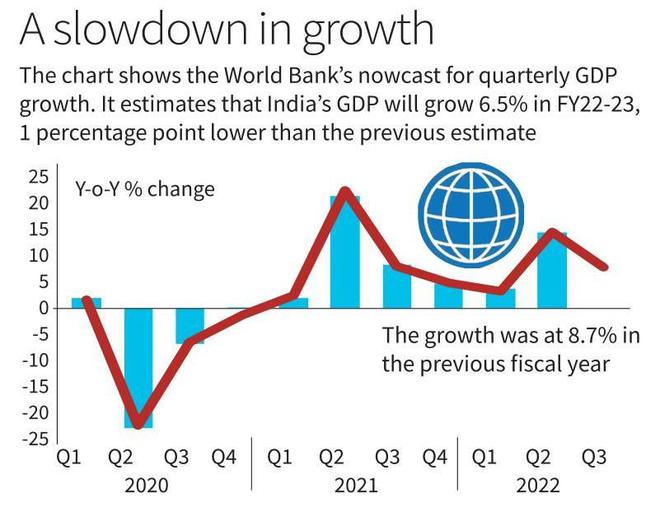The World Bank has estimated that India will grow 6.5% in the current fiscal year (FY22-23), after having grown at 8.7% in the fiscal year ended March 31.
The estimate for the current year was revised downwards by one percentage point since June due to persistent pressures. The Indian economy is expected to speed up to 7.0% in the next fiscal year, before settling back down to 6.1% in FY24-25.

The numbers were released as part of the World Bank’s twice yearly South Asia Economic Focus, titled, ‘Coping with Shocks: Migration and the Road to Resilience’, ahead of the World Bank IMF annual meetings in Washington DC.
With Sri Lanka’s economic crisis, the devastating floods in Pakistan, and recovery from the pandemic impacted by the war in Ukraine, recovery in the region will be uneven, with the economies that are more services-led (India, Nepal, and Maldives) expected to “maintain a reasonable recovery trend despite headwinds”.
Afghanistan, Sri Lanka and Pakistan are more at risk and will see poverty increase in 2022.
The slowing in India’s growth during the current fiscal year, relative to the previous one, was because most of the COVID recovery happened last year, the report said. The impact of the Russia-Ukraine war, global monetary tightening, high commodity prices and interest rates impacting domestic demand (especially private consumption in FY2023-24), contributing to this slowing.
Manufacturing and services have been expanding in India since January, and growing at a rate faster than the rest of the world. With a relaxing of COVID restrictions, economic activity had picked up, as had demand in contact-intensive sectors.
Output had grown at an estimated 13.5% (year on year) in the April –June period this year, a contraction however, relative to the preceding quarter.
Services and construction had expanded the fastest on the production side, the report said, and private demand had grown year on year, but this was largely due to a low base effect from the second quarter of 2021 when the economy was reeling under the delta wave of Covid.
Although India growth estimates are above the South Asian average, there is weakness in employment and supply chains, the report says, with supply chain delays having improved only marginally since June this year. While India’s economy-wide employment index is improving on a monthly basis, it is doing so at speeds slower than the rest of the world (barring Asia).
While private consumption in India increased overall in quarter 2 of 2022, the recovery across income groups has been uneven, as per the World Bank. High income households’ consumption of contact-intensive services and consumer goods recovered, but for rural and low income households, consumption was weak. Return of migrant workers to their places of work has also been slow, impacting household incomes in cases where migrants are sending money home.
“Pandemics, sudden swings in global liquidity and commodity prices, and extreme weather disasters were once tail-end risks. But all three have arrived in rapid succession over the past two years and are testing South Asia’s economies,” said Martin Raiser, World Bank Vice President for the South Asian region.
“In the face of these shocks, countries need to build stronger fiscal and monetary buffers, and reorient scarce resources towards strengthening resilience to protect their people,” he said.
As a whole, South Asia, excluding Afghanistan, is forecast to grow at 5.8% for the current calendar year and the next two years, having grown at 7.8% in 2021. The Sri Lanka forecast is particularly severe – a contraction of 9.2% this calendar year and a contraction of 4.2% next year before it a growth forecast of 1% in 2024.







